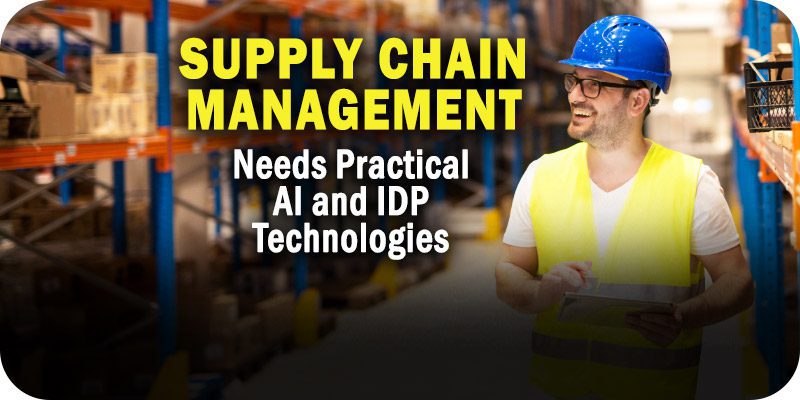Supply Chain Management Needs Practical AI & IDP Technologies


As part of Solutions Review’s Contributed Content Series—a collection of articles written by industry thought leaders in maturing software categories—Tomas Gogar, CEO and co-founder of Rossum, explains why supply chain management should start incorporating practical AI and IDP technologies in its strategies.
Artificial intelligence (AI) holds irrefutable potential for improving business operations, but not always in the way people might think. For some, AI in the supply chain conjures up images of robots managing conveyor belts or drones accelerating delivery times. While this may eventually be the case, the uses of AI in modern supply chain management strategies are much more practical.
Supply chains are under immense pressure to deliver goods on time, either to other organizations or directly to the consumer. This is further exacerbated due to staffing shortages across the country, reducing the number of employees available for daily operational tasks.
AI-powered Intelligent Document Processing (IDP) can replace manual data entry with automated data capture, enabling the digital extraction and export of information in just minutes, simplifying customs compliance, and mitigating backlogs. By integrating AI applications that fine-tune user experience and provide immediate, measurable outcomes, the supply chain industry can streamline everyday operations and simplify manual data entry, saving businesses time and money.
Widget not in any sidebars
Here are some best use case examples for incorporating IDP into supply chain management operations and the obstacles this technology can overcome:
Manual Data Entry Errors
Gartner predicts that every year, poor data quality costs organizations an average of $12.9 million. Many factors contribute to this statistic, and manual data entry plays a prominent role. Not only is it time-consuming, but it increases the likelihood of introducing human error. As errors add up, data quality becomes worse, leading to ill-informed business decisions. Further, manual data entry can leave supply chains with outdated information because employees cannot keep up with the volume. The rush to keep up may precede input data quality, causing businesses to have inaccurate information and outdated data resulting in inefficiencies and poor decisions.
In 2020, a study cited manual data entry as one of the most hated office tasks in the workforce, contributing to high employee turnover. IDP eliminates manual data entry, allowing employees to focus on higher-value tasks. Data quality subsequently improves, and data is processed faster, saving businesses money and time.
Data Inconsistencies
If a company has manual data entry positions, there’s a high likelihood more than one person covers this role. Increased staffing may reduce the time it takes to log such data into the system, but it can also lead to data inconsistencies. For example, each employee responsible for manual data entry may define a category differently or interpret the data differently. Therefore, information may be entered correctly but displaced or inconsistently sorted, worsening the quality of data available to the company. While this can be scaled down with proper training, that doesn’t erase the chances of such discordance.
IDP delivers consistency and quality within data entry. The system can read the document as a human would, but it will better recognize and sort content without blindly analyzing the formatting. As the AI system is used more, it will become even better at data capture, making all entries more accurate. This can drastically cut down the number of data conflicts across supply chains.
Ongoing Backlogs
Backlogs and bottlenecks are constantly contributing to delays in shipping and logistics. This problem for individual companies can negatively impact the global economy. Companies could address this by pausing on sales and orders when addressing backlogs, but a constant revenue stream needs to be guaranteed to keep companies running. From here, the backlogs continue to stack up, exacerbating the problem and frustrating customers and employees. As the supply chain expands, it becomes increasingly impractical for a person to be in charge of addressing these backlogs.
IDP slashes the time it takes to address backlogs, allowing for faster delivery of goods. Invoices would have a quicker output, document inaccuracies would be identified faster, and the system could incorporate real-time error correction feedback. Inaccuracies get addressed immediately, and the need for backtracking further down the process is eliminated.
Add email integration, and IDP becomes even more powerful. Imagine being able to proactively keep suppliers in the loop with automated email notifications and status updates. It is now possible to automate notifications and alerts, route payment and invoice information, acknowledge receipts, and provide status and follow-up updates, all via email.
According to IDC, the worldwide IDP market will grow at a compound annual growth rate of 23.1 percent over the next five years. Nearly all industries are beginning to recognize the importance of incorporating IDP into their business model.
Yet, AI advancements in the supply chain—or any industry—will not occur overnight. When engineering new technology, improvement is always a gradual effort. To secure the best AI possible for the supply chain, it’s essential to start by implementing AI at a foundational level. IDP provides the AI essentials needed to automate and streamline workflows resulting in greater operational agility. This technology eliminates mundane manual data entry while providing a gateway to a collective future that can support those drones and robots that capture everyone’s attention.























